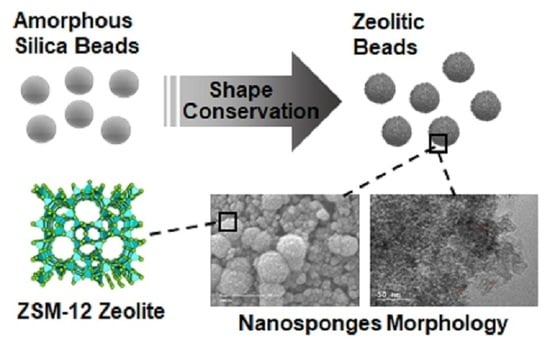Guided Crystallization of Zeolite Beads Composed of ZSM-12 Nanosponges
Abstract
1. Introduction
2. Materials and Methods
2.1. Preparation of ZSM-12 Beads
2.1.1. Synthesis of the Dual-Porogenic Surfactant Template
2.1.2. Synthesis of ZSM-12 Nanosponges Beads
2.2. Characterization of Zeolite Beads
3. Results and Discussion
4. Conclusions
Supplementary Materials
Author Contributions
Funding
Acknowledgments
Conflicts of Interest
References
- Dusselier, M.; Van Wouwe, P.; Dewaele, A.; Jacobs, P.A.; Sels, B.F. Shape-selective zeolite catalysis for bioplastics production. Science 2015, 349, 78–80. [Google Scholar] [CrossRef] [PubMed]
- Zhang, R.; Liu, N.; Lei, Z.; Chen, B. Selective transformation of various nitrogen-containing exhaust gases toward N2 over zeolite catalysts. Chem. Rev. 2016, 116, 3658–3721. [Google Scholar] [CrossRef] [PubMed]
- Valtchev, V.; Majano, G.; Mintova, S.; Pérez-Ramírez, J. Tailored crystalline microporous materials by post-synthesis modification. Chem. Soc. Rev. 2013, 42, 263–290. [Google Scholar] [CrossRef] [PubMed]
- Smit, B.; Maesen, T.L.M. Towards a molecular understanding of shape selectivity. Nature 2008, 451, 671–678. [Google Scholar] [CrossRef]
- Deroche, I.; Daou, T.J.; Picard, C.; Coasne, B. Reminiscent capillarity in subnanopores. Nat. Commun. 2019, 10, 4642. [Google Scholar] [CrossRef] [PubMed]
- Huve, J.; Ryzhikov, A.; Nouali, H.; Lalia, V.; Augé, G.; Daou, T.J. Porous sorbents for the capture of radioactive iodine compounds: A review. RSC Adv. 2018, 8, 29248–29273. [Google Scholar] [CrossRef]
- Reddy, J.K.; Motokura, K.; Koyama, T.; Miyaji, A.; Baba, T. Effect of morphology and particle size of ZSM-5 on catalytic performance for ethylene conversion and heptane cracking. J. Catal. 2012, 289, 53–61. [Google Scholar] [CrossRef]
- Zhang, H.; Hu, Z.; Huang, L.; Zhang, H.; Song, K.; Wang, L.; Shi, Z.; Ma, J.; Zhuang, Y.; Shen, W.; et al. dehydration of glycerol to acrolein over hierarchical ZSM-5 zeolites: Effects of mesoporosity and acidity. ACS Catal. 2015, 5, 2548–2558. [Google Scholar] [CrossRef]
- Kabalan, I.; Lebeau, B.; Nouali, H.; Toufaily, J.; Hamieh, T.; Koubaissy, B.; Bellat, J.-P.; Daou, T.J. New generation of zeolite materials for environmental applications. J. Phys. Chem. C 2016, 120, 2688–2697. [Google Scholar] [CrossRef]
- Astafan, A.; Pouilloux, Y.; Patarin, J.; Bats, N.; Bouchy, C.; Daou, T.J.; Pinard, L. Impact of extreme downsizing of *BEA-type zeolite crystals on n -hexadecane hydroisomerization. New J. Chem. 2016, 40, 4335–4343. [Google Scholar] [CrossRef]
- Larlus, O.; Valtchev, V.P. Crystal morphology control of LTL-type zeolite crystals. Chem. Mater. 2004, 16, 3381–3389. [Google Scholar] [CrossRef]
- Drews, T.O.; Tsapatsis, M. Progress in manipulating zeolite morphology and related applications. Curr. Opin. Colloid Interface Sci. 2005, 10, 233–238. [Google Scholar] [CrossRef]
- Wakihara, T.; Ihara, A.; Inagaki, S.; Tatami, J.; Sato, K.; Komeya, K.; Meguro, T.; Kubota, Y.; Nakahira, A. Top-down tuning of nanosized ZSM-5 zeolite catalyst by bead milling and recrystallization. Cryst. Growth Des. 2011, 11, 5153–5158. [Google Scholar] [CrossRef]
- Tao, Y.; Kanoh, H.; Abrams, L.; Kaneko, K. Mesopore-modified zeolites: Preparation, characterization, and applications. Chem. Rev. 2006, 106, 896–910. [Google Scholar] [CrossRef]
- Pérez-Ramírez, J.; Verboekend, D.; Bonilla, A.; Abelló, S. Zeolite catalysts with tunable hierarchy factor by pore-growth moderators. Adv. Funct. Mater. 2009, 19, 3972–3979. [Google Scholar] [CrossRef]
- Zhang, B.; Zhang, Y.; Hu, Y.; Shi, Z.; Azhati, A.; Xie, S.; He, H.; Tang, Y. Microexplosion under microwave irradiation: A facile approach to create mesopores in zeolites. Chem. Mater. 2016, 28, 2757–2767. [Google Scholar] [CrossRef]
- Choi, M.; Na, K.; Kim, J.; Sakamoto, Y.; Terasaki, O.; Ryoo, R. Stable single-unit-cell nanosheets of zeolite MFI as active and long-lived catalysts. Nature 2009, 461, 246–249. [Google Scholar] [CrossRef]
- Xu, D.; Ma, Y.; Jing, Z.; Han, L.; Singh, B.; Feng, J.; Shen, X.; Cao, F.; Oleynikov, P.; Sun, H.; et al. π–π interaction of aromatic groups in amphiphilic molecules directing for single-crystalline mesostructured zeolite nanosheets. Nat. Commun. 2014, 5, 4262. [Google Scholar] [CrossRef]
- Singh, B.K.; Xu, D.; Han, L.; Ding, J.; Wang, Y.; Che, S. Synthesis of single-crystalline mesoporous ZSM-5 with three-dimensional pores via the self-assembly of a designed triply branched cationic surfactant. Chem. Mater. 2014, 26, 7183–7188. [Google Scholar] [CrossRef]
- Kore, R.; Srivastava, R.; Satpati, B. ZSM-5 zeolite nanosheets with improved catalytic activity synthesized using a new class of structure-directing agents. Chem. Eur. J. 2014, 20, 11511–11521. [Google Scholar] [CrossRef]
- Na, K.; Jo, C.; Kim, J.; Cho, K.; Jung, J.; Seo, Y.; Messinger, R.J.; Chmelka, B.F.; Ryoo, R. Directing zeolite structures into hierarchically nanoporous architectures. Science 2011, 333, 328–332. [Google Scholar] [CrossRef] [PubMed]
- Dhainaut, J.; Daou, T.J.; Bidal, Y.; Bats, N.; Harbuzaru, B.; Lapisardi, G.; Chaumeil, H.; Defoin, A.; Rouleau, L.; Patarin, J. One-pot structural conversion of magadiite into MFI zeolite nanosheets using mononitrogen surfactants as structure and shape-directing agents. Cryst. Eng. Comm 2013, 15, 3009–3015. [Google Scholar] [CrossRef]
- Rioland, G.; Albrecht, S.; Josien, L.; Vidal, L.; Daou, T.J. The influence of the nature of organosilane surfactants and their concentration on the formation of hierarchical FAU-type zeolite nanosheets. New J. Chem. 2015, 39, 2675–2681. [Google Scholar] [CrossRef]
- Kabalan, I.; Rioland, G.; Nouali, H.; Lebeau, B.; Rigolet, S.; Fadlallah, M.-B.; Toufaily, J.; Hamiyeh, T.; Daou, T.J. Synthesis of purely silica MFI-type nanosheets for molecular decontamination. RSC Adv. 2014, 4, 37353–37358. [Google Scholar] [CrossRef]
- El Hanache, L.; Lebeau, B.; Nouali, H.; Toufaily, J.; Hamieh, T.; Daou, T.J. Performance of surfactant-modified *BEA-type zeolite nanosponges for the removal of nitrate in contaminated water: Effect of the external surface. J. Hazard. Mater. 2019, 364, 206–217. [Google Scholar] [CrossRef]
- El Hanache, L.; Sundermann, L.; Lebeau, B.; Toufaily, J.; Hamieh, T.; Daou, T.J. Surfactant-modified MFI-type nanozeolites: Super-adsorbents for nitrate removal from contaminated water. Microporous Mesoporous Mater. 2019, 283, 1–13. [Google Scholar] [CrossRef]
- Lupulescu, A.I.; Rimer, J.D. Tailoring silicalite-1 crystal morphology with molecular modifiers. Angew. Chem. Int. Ed. 2012, 51, 3345–3349. [Google Scholar] [CrossRef]
- Lupulescu, A.I.; Kumar, M.; Rimer, J.D. A facile strategy to design zeolite L crystals with tunable morphology and surface architecture. J. Am. Chem. Soc. 2013, 135, 6608–6617. [Google Scholar] [CrossRef] [PubMed]
- Gaona Gomez, A.; de Silveira, G.; Doan, H.; Cheng, C.-H. A facile method to tune zeolite L crystals with low aspect ratio. Chem. Commun. 2011, 47, 5876–5878. [Google Scholar] [CrossRef]
- Zhang, H.; Zhao, Y.; Zhang, H.; Wang, P.; Shi, Z.; Mao, J.; Zhang, Y.; Tang, Y. Tailoring zeolite ZSM-5 crystal morphology/porosity through flexible utilization of silicalite-1 seeds as templates: Unusual crystallization pathways in a heterogeneous system. Chem. Eur. J. 2016, 22, 7141–7151. [Google Scholar] [CrossRef]
- Zhang, W.; Smirniotis, P.G. On the exceptional time-on-stream stability of HZSM-12 zeolite: Relation between zeolite pore structure and activity. Catal. Lett. 1999, 60, 223–228. [Google Scholar] [CrossRef]
- Rosinski, E.J.; Rubin, M.K. Preparation of ZSM-12 Type Zeolites. U.S. Patent 4,391,785, 5 July 1983. [Google Scholar]
- LaPierre, R.B.; Rohrman, A.C.; Schlenker, J.L.; Wood, J.D.; Rubin, M.K.; Rohrbaugh, W.J. The framework topology of ZSM-12: A high-silica zeolite. Zeolites 1985, 5, 346–348. [Google Scholar] [CrossRef]
- Kokotailo, G.T.; Fyfe, C.A.; Feng, Y.; Grondey, H.; Gies, H.; Marler, B.; Cox, D.E. Powder X-ray diffraction and solid state NMR techniques forzeolite structure determination. In Studies in Surface Science and Catalysis; Beyer, H.K., Karge, H.G., Kiricsi, I., Nagy, J.B., Eds.; Catalysis by Microporous Materials Elsevier: Amsterdam, The Netherlands, 1995; Volume 94, pp. 78–100. [Google Scholar]
- Pazzuconi, G.; Terzoni, G.; Perego, C.; Bellussi, G. Selective alkylation of naphthalene to 2,6-dimethylnaphthalene catalyzed by MTW zeolite. In Studies in Surface Science and Catalysis; Elsevier: Amsterdam, Netherlands, 2001; Volume 135, p. 152. ISBN 978-0-444-50238-4. [Google Scholar]
- Pazzucconi, G.; Perego, C.; Millini, R.; Frigerio, F.; Mansani, R.; Rancati, D. Process for the Preparation of 2,6-dimethylnaphthalene Using a MTW Zeolitic Catalyst. U.S. Patent 6,147,270, 14 November 2000. [Google Scholar]
- Dugkhuntod, P.; Imyen, T.; Wannapakdee, W.; Yutthalekha, T.; Salakhum, S.; Wattanakit, C. Synthesis of hierarchical ZSM-12 nanolayers for levulinic acid esterification with ethanol to ethyl levulinate. RSC Adv. 2019, 9, 18087–18097. [Google Scholar] [CrossRef]
- Itani, L.; Valtchev, V.; Patarin, J.; Rigolet, S.; Gao, F.; Baudin, G. Centimeter-sized zeolite bodies of intergrown crystals: Preparation, characterization and study of binder evolution. Microporous Mesoporous Mater. 2011, 138, 157–166. [Google Scholar] [CrossRef]
- Rioland, G.; Bullot, L.; Daou, T.J.; Simon-Masseron, A.; Chaplais, G.; Faye, D.; Fiani, E.; Patarin, J. Elaboration of FAU-type zeolite beads with good mechanical performances for molecular decontamination. RSC Adv. 2015, 6, 2470–2478. [Google Scholar] [CrossRef]
- Rioland, G.; Daou, T.J.; Faye, D.; Patarin, J. A new generation of MFI-type zeolite pellets with very high mechanical performance for space decontamination. Microporous Mesoporous Mater. 2016, 221, 167–174. [Google Scholar] [CrossRef]
- Fawaz, E.G.; Salam, D.A.; Nouali, H.; Deroche, I.; Rigolet, S.; Lebeau, B.; Daou, T.J. Synthesis of binderless ZK-4 zeolite microspheres at high temperature. Molecules 2018, 23, 2647. [Google Scholar] [CrossRef]
- Tosheva, L.; Valtchev, V.; Sterte, J. Silicalite-1 containing microspheres prepared using shape-directing macro-templates. Microporous Mesoporous Mater. 2000, 35–36, 621–629. [Google Scholar] [CrossRef]
- Mańko, M.; Vittenet, J.; Rodriguez, J.; Cot, D.; Mendret, J.; Brosillon, S.; Makowski, W.; Galarneau, A. Synthesis of binderless zeolite aggregates (SOD, LTA, FAU) beads of 10, 70μm and 1mm by direct pseudomorphic transformation. Microporous Mesoporous Mater. 2013, 176, 145–154. [Google Scholar] [CrossRef]
- Didi, Y.; Said, B.; Cacciaguerra, T.; Nguyen, K.L.; Wernert, V.; Denoyel, R.; Cot, D.; Sebai, W.; Belleville, M.-P.; Sanchez-Marcano, J.; et al. Synthesis of binderless FAU-X (13X) monoliths with hierarchical porosity. Microporous Mesoporous Mater. 2019, 281, 57–65. [Google Scholar] [CrossRef]
- Said, B.; Cacciaguerra, T.; Tancret, F.; Fajula, F.; Galarneau, A. Size control of self-supported LTA zeolite nanoparticles monoliths. Microporous Mesoporous Mater. 2016, 227, 176–190. [Google Scholar] [CrossRef]
- Didi, Y.; Said, B.; Micolle, M.; Cacciaguerra, T.; Cot, D.; Geneste, A.; Fajula, F.; Galarneau, A. Nanocrystals FAU-X monoliths as highly efficient microreactors for cesium capture in continuous flow. Microporous Mesoporous Mater. 2019, 285, 185–194. [Google Scholar] [CrossRef]
- Moukahhal, K.; Daou, T.J.; Josien, L.; Nouali, H.; Toufaily, J.; Hamieh, T.; Galarneau, A.; Lebeau, B. Hierarchical ZSM-5 beads composed of zeolite nanosheets obtained by pseudomorphic transformation. Microporous Mesoporous Mater. 2019, 288, 109565. [Google Scholar] [CrossRef]
- Moukahhal, K.; Le, N.H.; Bonne, M.; Toufaily, J.; Hamieh, T.; Daou, T.J.; Lebeau, B. Controlled crystallization of hierarchical monoliths composed of nanozeolites. Cryst. Growth Des. 2020, 20, 5413–5423. [Google Scholar] [CrossRef]
- Moukahhal, K.; Lebeau, B.; Josien, L.; Galarneau, A.; Toufaily, J.; Hamieh, T.; Daou, T.J. Synthesis of hierarchical zeolites with morphology control: Plain and hollow spherical beads of silicalite-1 nanosheets. Molecules 2020, 25, 2563. [Google Scholar] [CrossRef] [PubMed]
- Landers, J.; Gor, G.Y.; Neimark, A.V. Density functional theory methods for characterization of porous materials. Colloids Surf. A 2013, 437, 3–32. [Google Scholar] [CrossRef]
- Mintova, S.; Ristić, A.; Rangus, M.; Novak Tušar, N. Verified Syntheses of Zeolitic Materials; Synthesis Commission of the International Zeolite Association: Caen, France, 2016; ISBN 978-0-692-68539-6. [Google Scholar]
- Thommes, M.; Cychosz, K.A. Physical adsorption characterization of nanoporous materials: Progress and challenges. Adsorption 2014, 20, 233–250. [Google Scholar] [CrossRef]
- Galarneau, A.; Mehlhorn, D.; Guenneau, F.; Coasne, B.; Villemot, F.; Minoux, D.; Aquino, C.; Dath, J.-P. Specific surface area determination for microporous/mesoporous materials: The case of mesoporous FAU-Y zeolites. Langmuir 2018, 34, 14134–14142. [Google Scholar] [CrossRef]
- Galarneau, A.; Villemot, F.; Rodriguez, J.; Fajula, F.; Coasne, B. Validity of the t-plot method to assess microporosity in hierarchical micro/mesoporous materials. Langmuir 2014, 30, 13266–13274. [Google Scholar] [CrossRef]
- Carvalho, K.T.G.; Urquieta-Gonzalez, E.A. Microporous–mesoporous ZSM-12 zeolites: Synthesis by using a soft template and textural, acid and catalytic properties. Catal. Today 2015, 243, 92–102. [Google Scholar] [CrossRef]
- Dimitrov, L.; Mihaylov, M.; Hadjiivanov, K.; Mavrodinova, V. Catalytic properties and acidity of ZSM-12 zeolite with different textures. Microporous Mesoporous Mater. 2011, 143, 291–301. [Google Scholar] [CrossRef]

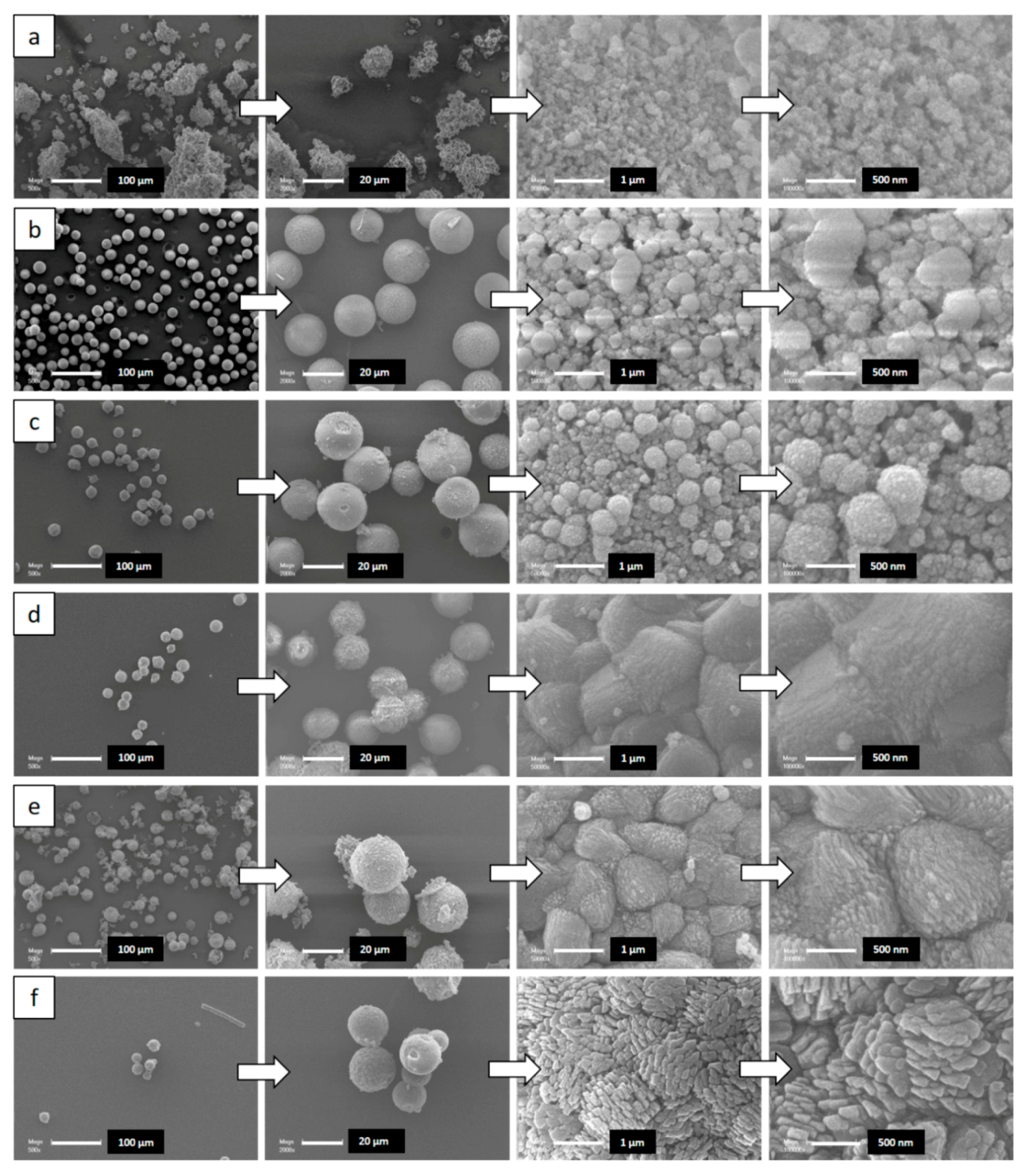

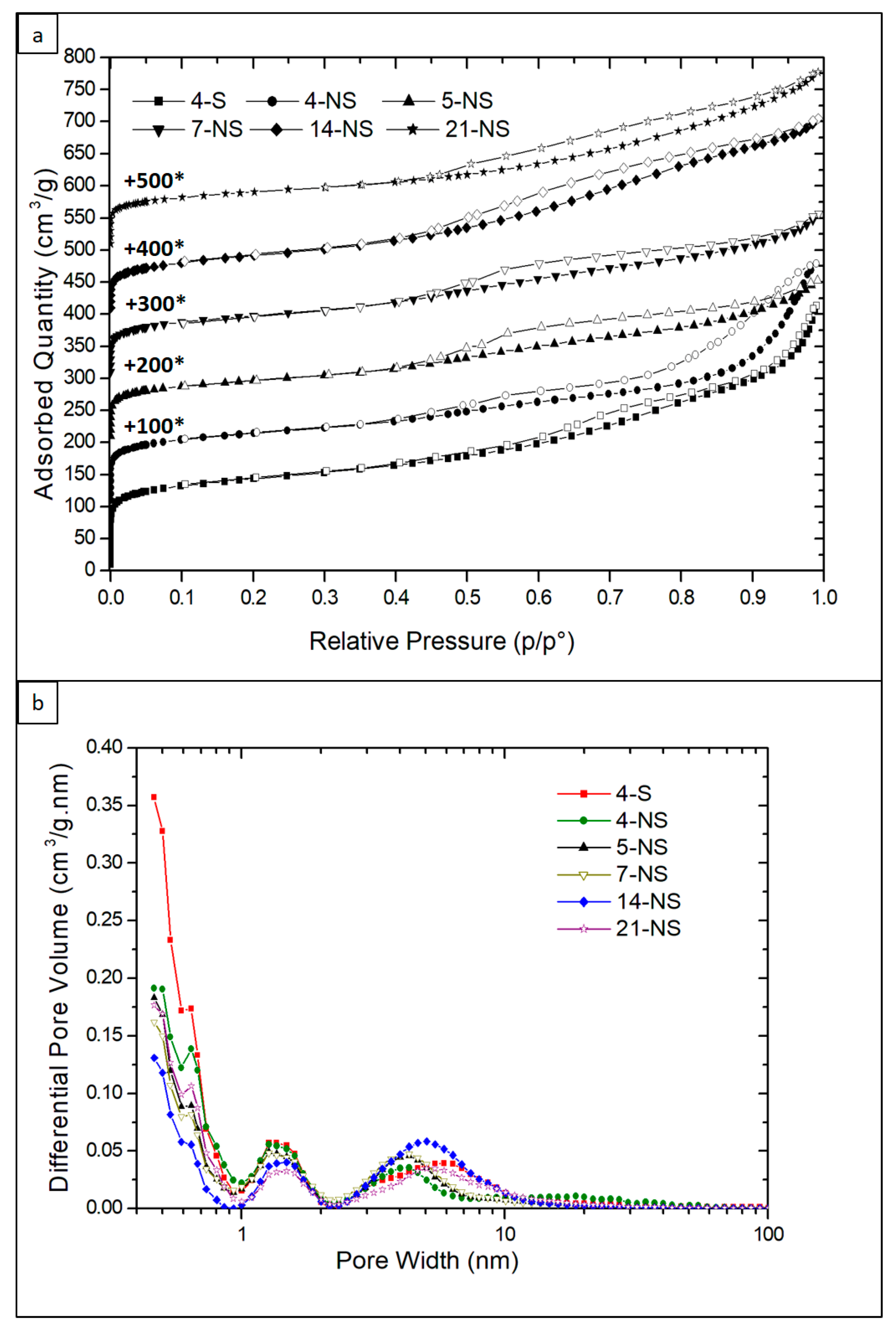
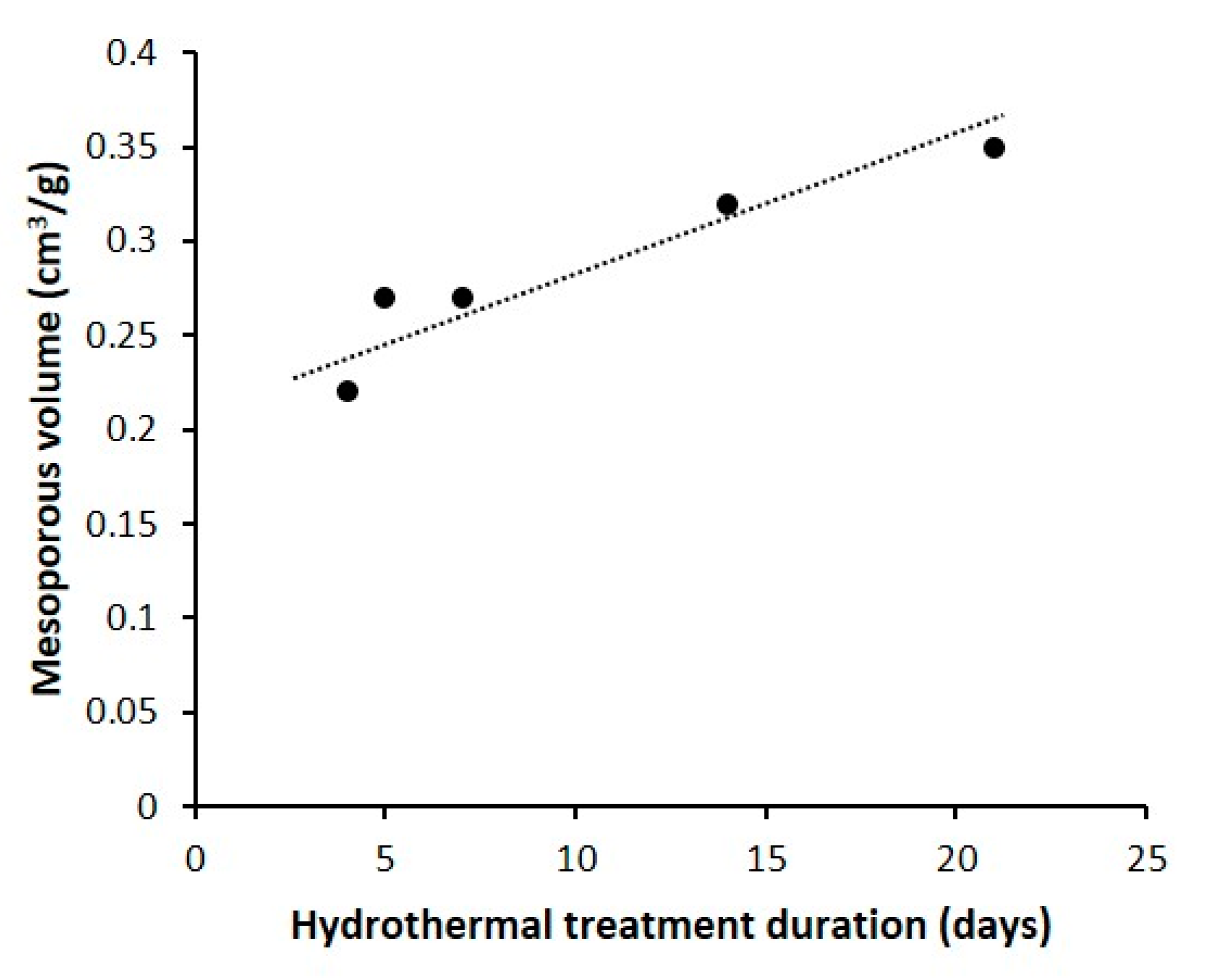
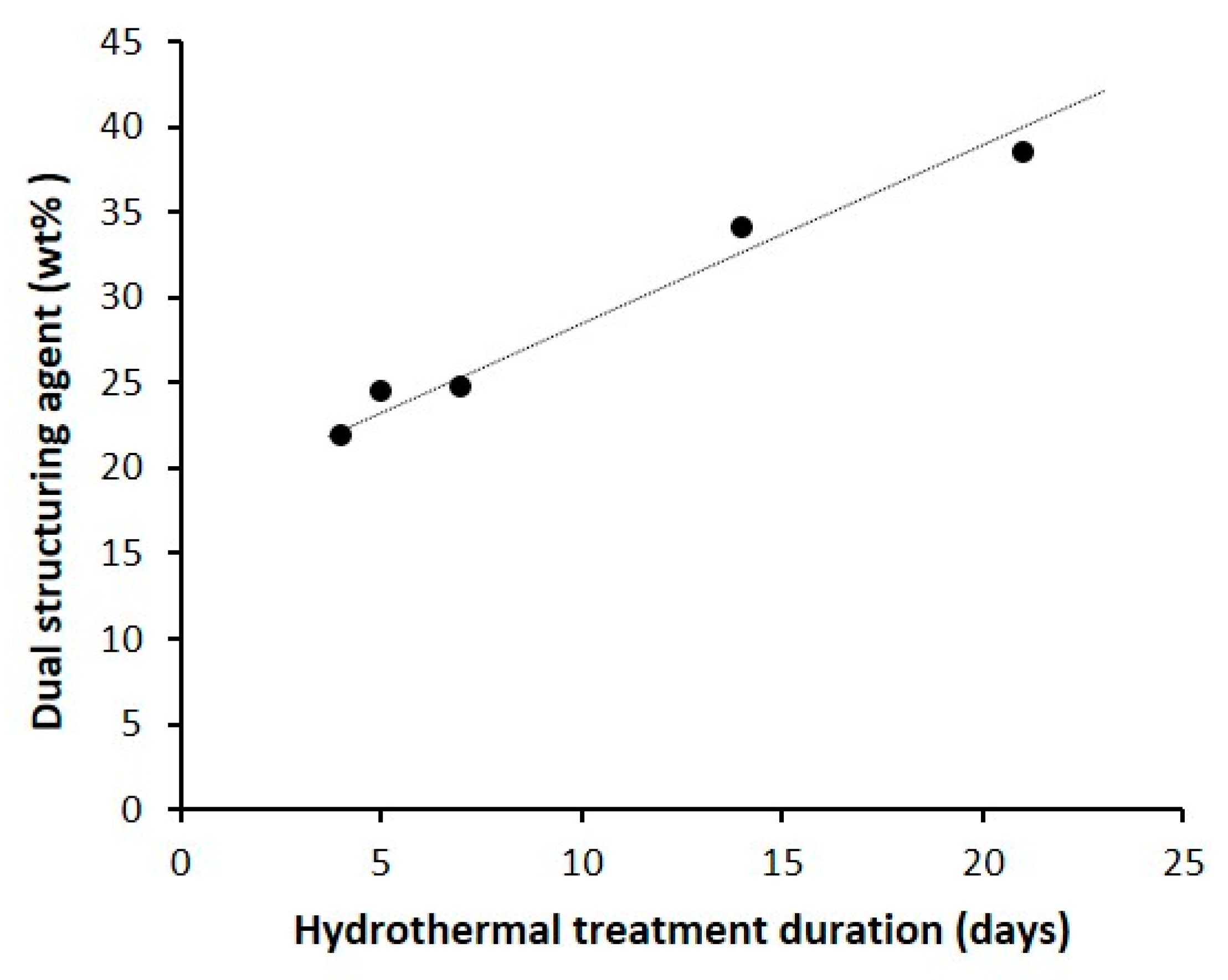
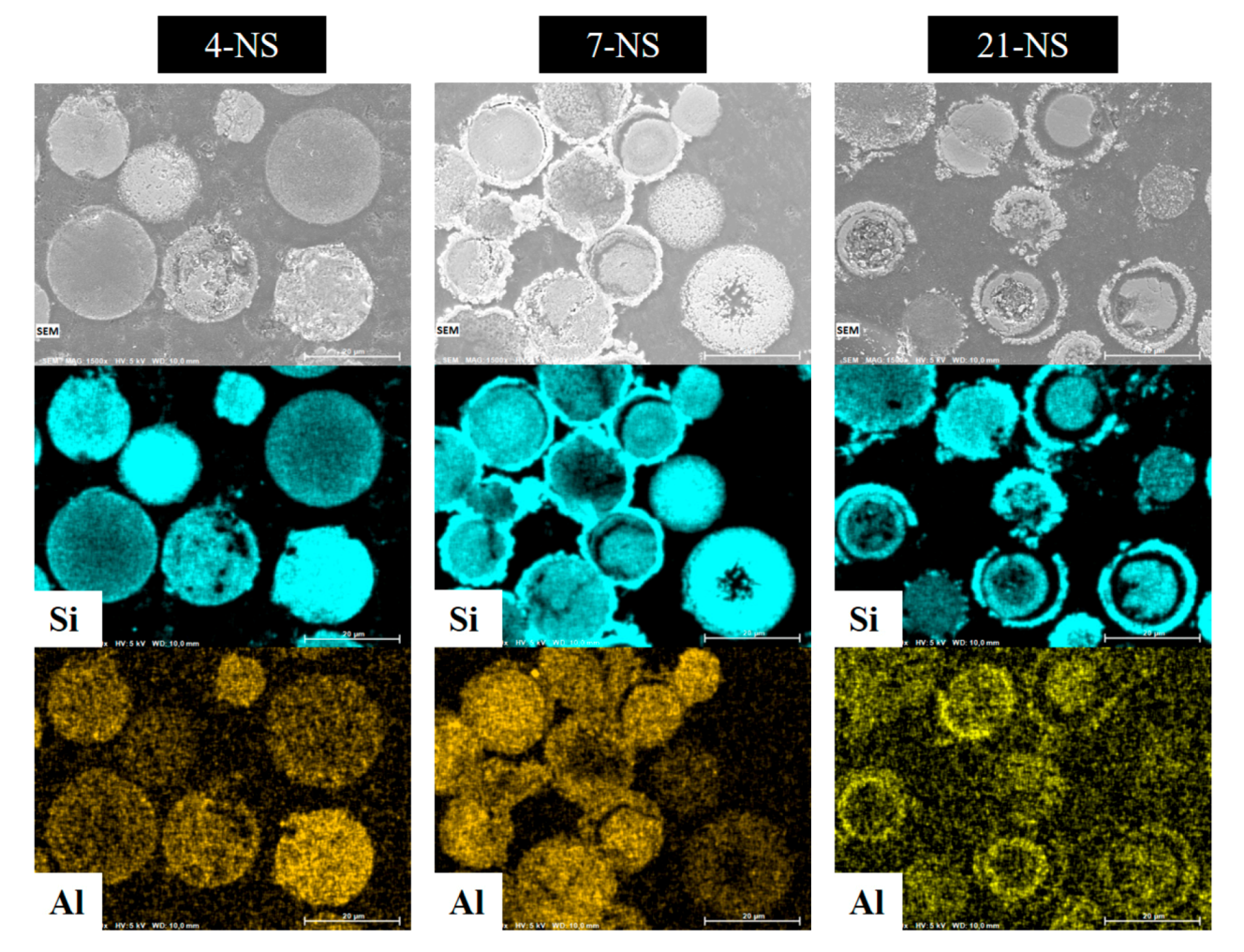
| SBET a (m2/g) | Vtot b (cm3/g) | Vmicro c (cm3/g) | Vmeso d (cm3/g) | Mesopores Diameter e (nm) | Physisorbed Water (%) f | Organic Matter (%) g | |
|---|---|---|---|---|---|---|---|
| 4-S | 498 | 0.51 (0.42) * | 0.19 | 0.32 (0.23) ** | 5.5 | 2.6 | 26 |
| 4-NS | 417 | 0.59 (0.37) * | 0.15 | 0.44 (0.22) ** | 5.8 | 3.8 | 22 |
| 5-NS | 351 | 0.39 | 0.12 | 0.27 | 4.2 | 3.3 | 24.5 |
| 7-NS | 347 | 0.40 | 0.13 | 0.27 | 4.1 | 3.6 | 24.8 |
| 14-NS | 328 | 0.43 | 0.11 | 0.32 | 5.6 | 4.2 | 34.1 |
| 21-NS | 327 | 0.47 | 0.12 | 0.35 | 4.5 | 2.6 | 38.5 |
© 2020 by the authors. Licensee MDPI, Basel, Switzerland. This article is an open access article distributed under the terms and conditions of the Creative Commons Attribution (CC BY) license (http://creativecommons.org/licenses/by/4.0/).
Share and Cite
Moukahhal, K.; Josien, L.; Nouali, H.; Toufaily, J.; Hamieh, T.; Daou, T.J.; Lebeau, B. Guided Crystallization of Zeolite Beads Composed of ZSM-12 Nanosponges. Crystals 2020, 10, 828. https://doi.org/10.3390/cryst10090828
Moukahhal K, Josien L, Nouali H, Toufaily J, Hamieh T, Daou TJ, Lebeau B. Guided Crystallization of Zeolite Beads Composed of ZSM-12 Nanosponges. Crystals. 2020; 10(9):828. https://doi.org/10.3390/cryst10090828
Chicago/Turabian StyleMoukahhal, Kassem, Ludovic Josien, Habiba Nouali, Joumana Toufaily, Tayssir Hamieh, T. Jean Daou, and Bénédicte Lebeau. 2020. "Guided Crystallization of Zeolite Beads Composed of ZSM-12 Nanosponges" Crystals 10, no. 9: 828. https://doi.org/10.3390/cryst10090828
APA StyleMoukahhal, K., Josien, L., Nouali, H., Toufaily, J., Hamieh, T., Daou, T. J., & Lebeau, B. (2020). Guided Crystallization of Zeolite Beads Composed of ZSM-12 Nanosponges. Crystals, 10(9), 828. https://doi.org/10.3390/cryst10090828








